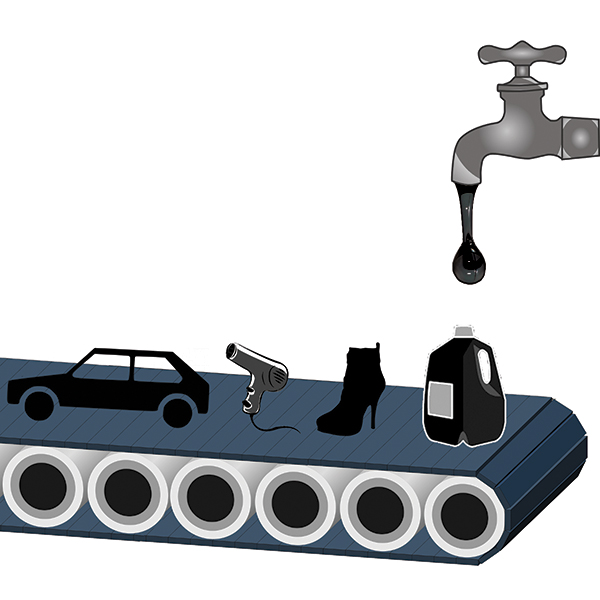
Finally, the price of gasoline is falling. That’s always a big relief and an effective way to stimulate the economy.
We are too busy to stop and think about the daily consumption of oil and gas, but almost everything we use or do has been produced using petroleum.
Our ordinary day-to-day products have been made using plastic or wax in some form. Some of these might be clothes (all permanent press), sports equipment, office supplies, electronics, toys, baby items, medications, household items, beauty items (including cologne and lipstick), building supplies, automotive materials, and foods (additives). The complete list is extensive but you get the picture.
Crude oil, also known as petroleum, is extracted from the ground via an oil rig and gets sent to a refinery. At the refinery the crude oil goes through a process called fraction distillation, from this we get liquid fractions that have distilled at different temperatures.
The distilled chemicals are cooled, sent to storage and then are used to make gasoline, lubricating oil, jet fuel, diesel and kerosene. Another by-product is liquid petroleum gas (LPG); this is used to make plastics and resins along with natural gas liquids (NGL).
Some fun facts about our consumption of oil and energy from U.S. Energy Information:
· About 191 million barrels of LPG and NGL were used in the making of plastics and resins in 2010, a million barrels of this was used as fuel. This amounted to a total 2.7 percent of the yearly consumption in the U.S.
· In 2010, about 65 billion kilowatt hours of electricity were used to make plastics, equal to 1.7 percent of the yearly total used in the U.S., the average home in California uses 6.9 megawatt hours per year.
· Additionally, 412 billion cubic feet of natural gas was used in making plastics and resins, this was about 1.7 percent of the total used in the U.S. in 2010.
Today there are 219 countries that produce oil, the top three being Russia, Saudi Arabia and the United States. According to the International Energy Agency the world consumes almost 90 million barrels of oil and liquid fuels on a daily basis – that’s 32 billion barrels for the year worldwide.
In the U.S., we consume a yearly average of 6.89 billion barrels of petroleum products.
California has 18 refineries and is ranked third in the nation for its refining capacity. And yet, according to the Energy Almanac on CA.gov, the state still imports 62.8 percent of the petroleum it needs. California spent $59.7 billion to import gasoline and diesel in 2007. The state government must be breathing a sigh of relief with the lower gas prices. But how long will it last?
Supply and demand. We have an overabundance of oil available thus helping to create the falling prices. Unfortunately this has a trickling affect in the oil industry leaving us with many unstable factors to consider.
Will U.S. oil producers have to shut down if the prices continue to drop? The big producers say in order to maintain productivity, the price of oil needs to stay above $80 per barrel. Saudi Arabia oil producers need only $50 per barrel to remain profitable, and they currently have an abundance of oil too.
If U.S. producers stop drilling, then we start to lose refineries, which will decrease the amount of gasoline available, creating a shortage and driving prices back up again.
Also, without getting too deep into the political aspects of oil productions and the fight to obtain wealth, the Organization of the Petroleum Exporting Countries (OPEC) has the ability to manipulate the cost of oil using production quotas. A change in quota should be on the agenda.
OPEC, an intergovernmental organization formed in 1960, now has 12 countries to represent. Saudi Arabia, Iran, Iraq, Kuwait and Venezuela are the founding countries. The goal of OPEC is to keep prices fair and stable for its members and unify petroleum policies along with assuring a fair return on their investments. They act essentially as a union. To belong to OPEC, a country must have a substantial net export of crude petroleum, and have fundamentally similar interests.
With everyday usages of this black gold, the prices of our products made using LPG and NGL don’t fluctuate with barrels of oil because getting them to market is more than just gas for the transport and delivery trucks. In fact you’ll see these prices begin to rise, especially with wage increases, production costs and rising energy costs.
It is amazing how the making of a simple tube of Maybelline lipstick took such a complicated journey to the department store just to be sold for $5.














Bryan Stanley • Nov 15, 2024 at 3:13 pm
Amazing Blog!
This Blog is so impactful.
We are also providing Petroleum Services in Venezuela.